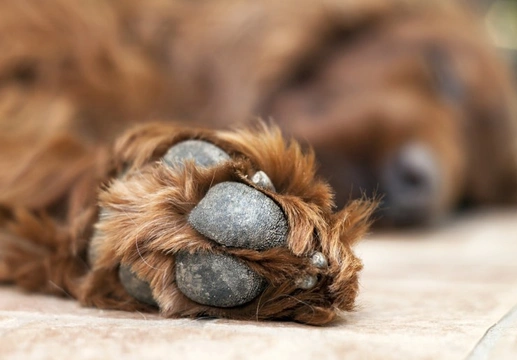
Hyperkeratosis in dogs
Hyperkeratosis is a canine health condition that leads to certain areas of the skin on the pads of the paws or the dog’s nose, becoming thicker than usual and also, harder. Not all affected dogs will present with the condition on both their nose and their paws; in some cases, it will be restricted to just one or the other.
Whilst hyperkeratosis in dogs can occur as a secondary complication of certain canine health conditions, it can also present as a hereditary health condition that is particularly associated with certain breeds and types of dogs-but this can be tested for in the most commonly affected breeds prior to making the decision to mate your dogs.
In this article, we will look at canine hyperkeratosis in more detail, and what it means for affected dogs and their potential offspring. Read on to learn more.
What is hyperkeratosis?
Hyperkeratosis leads to a hardening and thickening of the skin on the dog’s nose, feet or both. On the nose it is called nasal hyperkeratosis and on the paws it is known as foot pad keratosis, and as mentioned, not all dogs will suffer from both types of the condition at once.
The root of hyperkeratosis is keratin, a type of fibre-rich protein that forms the outer, protective layer of the dog’s skin, and which has a different thickness and consistency on the nose and foot pads than that of the skin on the rest of the body.
When the body produces too much keratin, too much of this thick skin grows in the affected area, which in time becomes hard, dry and prone to cracking. If the area in question does crack, this places the dog at risk of infection; the hard, dry skin is also often uncomfortable and can lead to problems walking when on the feet, and of course if it does crack, this can also be painful.
In foot pad hyperkeratosis, the claws also tend to grow faster and longer than usual, and these too can become misshapen and weak as a result of this.
Why does it occur?
Hyperkeratosis in dogs can be attributed to two different causes: as the result of a hereditary predisposition to the disease, or as a secondary side effect of another health condition. Some of the other conditions that may lead to hyperkeratosis as a secondary condition include:
- Canine distemper.
- Pemphigus foliaceus.
- Leishmaniasis.
- Zinc-responsive dermatosis.
As a hereditary condition, it is much more prevalent in certain breeds and types of dogs than other, with those at the highest risk of the condition being the Dogue de Bordeaux, the Irish terrier and the Kromfohrlander.
Testing for canine hyperkeratosis
It is possible to DNA test dogs with theHereditary Footpad Hyperkeratosis (HFH) testto find out if they carry the relevant genetic markers for the condition, and The Kennel Club strongly recommends that owners of the three breeds of dog mentioned above test their breeding stock prior to making the decision to breed from them.
In terms of the chances of a dog inheriting the condition from their parents, hyperkeratosis has an autosomal recessive means of transmission, which means that how likely a litter of puppies is to develop the condition can vary, depending on the status of the two parent dogs.
- If both parent dogs are clear, their offspring will be too.
- If one parent is clear and one a carrier, there is a 50% chance of each of their puppies becoming a carrier.
- If both parents are carriers, the odds for the litter are 50% carriers, 25% clear, and 25% affected.
- If one parent is clear and the other affected, all of the litter will be carriers.
- If one parent is a carrier and the other affected, 50% will be carriers, and 50% affected.
- If both parents are affected, all of the litter too will be affected.
Can it be prevented?
There is no way to prevent a dog that has inherited the appropriate carrier or affected status for the condition from developing it if this is the case, and the best way to prevent the condition is to DNA test the parents and use this information to make an informed decision on whether or not to breed.
As we mentioned earlier on, the condition can also occur as a side effect of certain other canine health conditions, and so preventing or treating these is the key to resolving the issue in dogs suffering from hyperkeratosis for non-hereditary reasons.
Can it be treated?
Unfortunately, hyperkeratosis in dogs cannot be cured-but it can be managed and kept under control, in order to maintain the dog’s quality of life. Properly controlled and regularly managed, the condition should not be uncomfortable or painful for your dog; but it does mean that they will need to see the vet regularly to have excess skin trimmed off and kept under control, and this will be the case for the entirety of the affected dog’s life.



